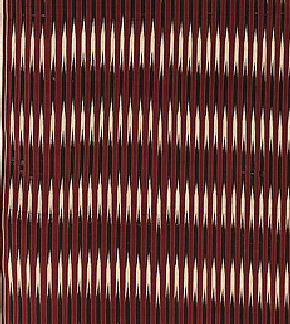| |
 
 | | | |
203 Sumatra, Aceh
Ija (man's sarong)  
| | Locale: | Village unknown. | | Period: | 1800-1850 | | Yarn: | Silk, hand-spun, very fine | | Technique: | Warp ikat | | Panels: | 1 | | Size: | 83 x 94 cm (2' 8" x 3' 1") LW: 1.13 | | Weight: | 58 g (2.0 oz), 74 g/m2 (0.24 oz/ft2) | | Design: | Ija plang rusa or ija plang rutha decorated in warp ikat. White arrowheads with black shafts on maroon field. Note that when worn the stripes would run horizontal. One of the sets of yarns was intentionally not aligned with all the others, creating a strange tension at one side of the cloth - a feature encountered only once on another 19th C. ija (see below). Not known is whether this is the top or the bottom of the sarong, but it is more likely to be the bottom as the top was often tucked in or hidden under a belt. | | Comment: | Rare old silk ikat man's waistcloth of highest ceremonial class, as marked by the originally white (now greyish) selvedge. Numerous tiny holes and thin spots, most of which the result of iron or other metals in the black dye which crystalized over time and with their sharp edges damaged the gossamer fine silk fibre. (Note the extremely low weight.) This type of Aceh cloth, which enjoyed high status in the wider region, and was de rigueur for the nobility in Kelantan, Malaysia, was the source of inspiration for cotton Batak ulos weaving. Unlike all pieces known from museums, this example was not opened up and remains sewn into a sarong. Warp length is 188 cm. Ex collection Carolyn Forbes. | | Background: | Chapters on Sumatra and Aceh. | | Published: | Ikat Textiles of the Indonesian Archipelago, 2018.
| | Compare: | 057 146 174 | | Sources: | Very similar to ija in Liefkes collection, depicted in Brinkgreve and Fox, Living with Indonesian Art, p. 34. Rijksmuseum Volkenkunde, but maroon rather than red. Similar to silk Aceh sarong in National Gallery of Australia, Nr. 1985.38. Also similar to one in Textile Museum of Canada, Nr. T85.0049. All three of these have been opened up for display, are in better overall condition, and may well be considerably younger. A similar 19th C. ija with one stripe pulled out of alignment was shown on the Asemus website at one time, but is inaccessible by now:
 | | |

©Peter ten Hoopen, 2025
All rights reserved.
|
|


